| Sandrecki | |
|---|---|
 | |
| Details | |
| Alternative names | Ślepowron variation Sandrecki |
| Earliest mention | 1697 |
| Towns | none |
| Families | Sandrecki, Sendraszyc |
Sandrecki is a Polish coat of arms. It was used by the Sandrecki szlachta family.
| Sandrecki | |
|---|---|
 | |
| Details | |
| Alternative names | Ślepowron variation Sandrecki |
| Earliest mention | 1697 |
| Towns | none |
| Families | Sandrecki, Sendraszyc |
Sandrecki is a Polish coat of arms. It was used by the Sandrecki szlachta family.
| | This section is empty. You can help by adding to it. (July 2010) |
| | This section is empty. You can help by adding to it. (July 2010) |

Nałęcz is a Polish coat of arms. It was used by associated szlachta families in the Kingdom of Poland and the Polish–Lithuanian Commonwealth (1569–1795).

Jastrzębiec is one of the most ancient Polish coat of arms. Dating back to the 10th century, it has been used by Poland's oldest szlachta families — Poland's Immemorial nobility — and remains in use today.
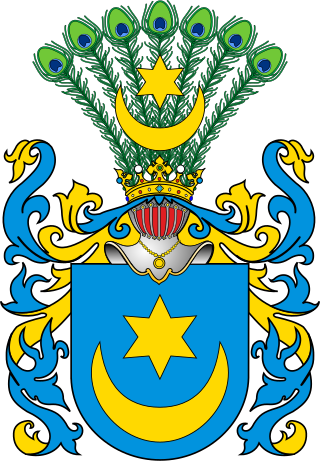
Leliwa is a Polish coat of arms. It was used by several hundred szlachta families during the existence of the Kingdom of Poland and the Polish–Lithuanian Commonwealth, and remains in use today by many of the descendants of these families. There are several forms of the arms, all of which bear the name, Leliwa, but which may be distinguished as variations of the same arms by the addition of a Roman numeral. In 19th century during a pan South-Slavic Illyrian movement heraldic term Leliwa also entered Croatian heraldry as a name for the coat of arms considered to be the oldest known symbol; Bleu celeste, a mullet of six points Or surmounted above a crescent Argent – A golden six-pointed star over a silver crescent moon on a blue shield, but also as a name for all other coats of arms that have a crescent and a mullet.

Pierzchała (Roch) is a Polish coat of arms. It was used by several szlachta families in the times of the Kingdom of Poland and the Polish–Lithuanian Commonwealth.

Geysztor or Gieysztor is a Polish coat of arms. It was used by several Szlachta families in the times of the Polish–Lithuanian Commonwealth.

Polish heraldry is the study of the coats of arms that have historically been used in Poland and the Polish–Lithuanian Commonwealth. It treats of specifically Polish heraldic traits and of the Polish heraldic system, contrasted with heraldic systems used elsewhere, notably in Western Europe. Due to the distinctive ways in which feudal societies evolved. Poland's heraldic traditions differ substantially from those of the modern-day German lands and France.
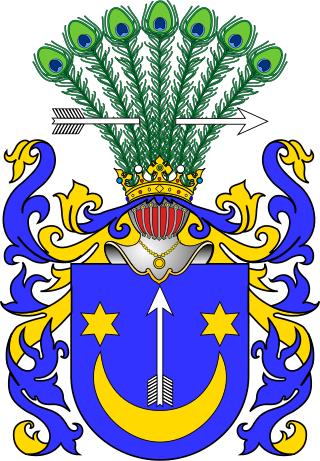
Sas or Szász is a Central European coat of arms. It was borne since the medieval period by several Transylvanian-Saxon Hungarian, Ruthenian, Ukrainian, and Polish-Lithuanian noble families. The house was once a mighty princely and ducal house with origins in Saxony, Transylvania, Hungary and Ruthenia.

Ślepowron is a Polish coat of arms. It was used by several szlachta families in the times of the Polish–Lithuanian Commonwealth. From the fifteenth century, the descendants of the Ślepowron family began to use names taken from their lands. This led to many different surnames being created within one family. The Ślepowron coat of arms is unique in Polish heraldry, in that it is the only coat of arms which is indicative a common origin of individual families, that is, the de Ślepowron, or Korwin, family. Wawrzęta Korwin de Ślepowron is the oldest known ancestor of the family, although the family's oral traditions claim that they descend from Marcus Valerius Corvus, a Roman general.

Wieniawa is a Polish coat of arms. It was used by several noble, in Polish language szlachta families in the times of medieval Poland and the Polish–Lithuanian Commonwealth.

Groty is a Polish coat of arms. It was used by several szlachta (noble) families under the Polish–Lithuanian Commonwealth.

Hełm is a Polish coat of arms. It was used by a number of szlachta (noble) families under the Polish–Lithuanian Commonwealth.

Pogoń Ruska is a Polish coat of arms with Ruthenian roots. It was used by several princely families of the stock from the Rurik dynasty in the times of the Polish–Lithuanian Commonwealth.

Ryc is a Polish coat of arms. It was used by the Ryc and Rydz szlachta families.

Oszyk is a Polish coat of arms. It was used by the Sienkiewicz family.
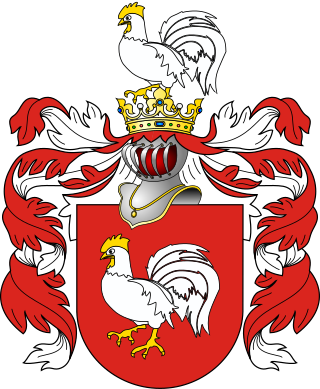
Kur is a Polish coat of arms. It was used by several noble families forming a Clan of Kur in the times of the Kingdom of Poland and the Polish–Lithuanian Commonwealth. It is noted during the reign of the Jagiellon dynasty and illustrated with its original name in the work of Bartosz Paprocki "Herby Rycerstwa Polskiego" in 1584. Furthermore, it is published in the work of Szymon Okolski in 1641. and several other publications
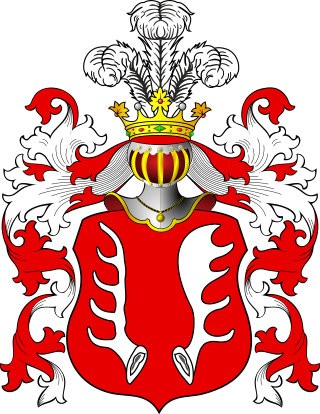
Iwanowski is a Polish coat of arms. It was used by the Iwanowski szlachta family.
Polish heraldry is typical to the Polish nobility/szlachta, which has its origins in Middle Ages knights/warriors clans that provided military support to the King, Dukes or overlords.
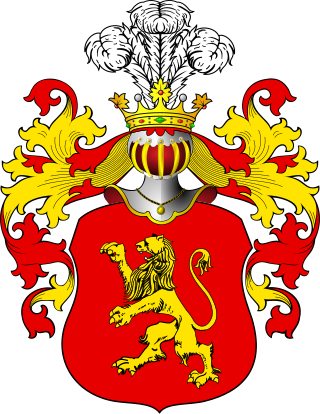
Lew II - Polish coat of arms, used by several genera. Two of them were families from the region of Kaszuby. Coat of arms "Lew II" is a variant of the coat of arms "Leo".

The coat of arms of the city of Gdańsk, in its current form, dates back to 1410 and Banderia Prutenorum. The coat of arms is very similar to the flag of Gdańsk. It depicts two silver crosses on a red shield above each other, above which hovers a golden crown. The greater arms also has two lions as supporters and Gdańsk motto.
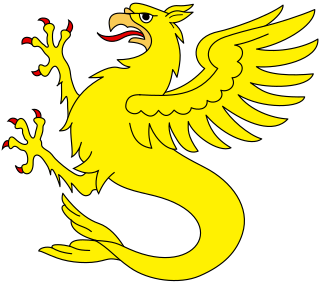
The sea-griffin is a heraldic charge in form of a creature with the upper-body of a griffin and the lower-half of a fish.